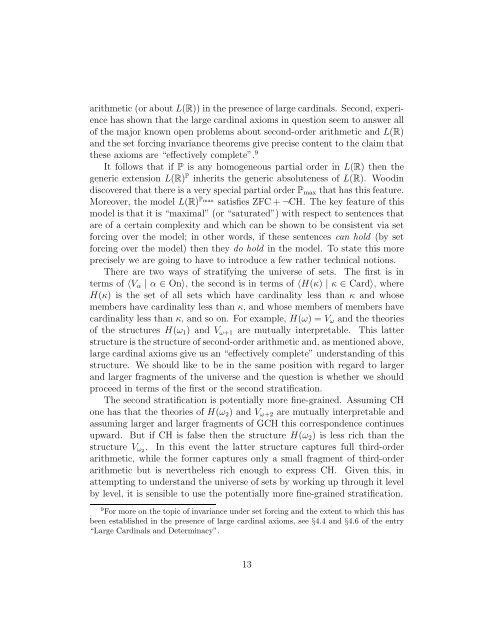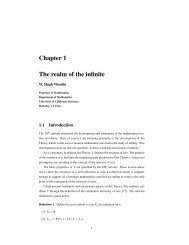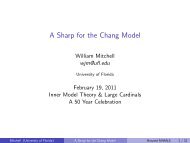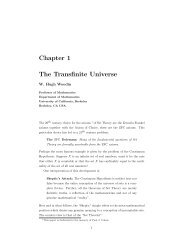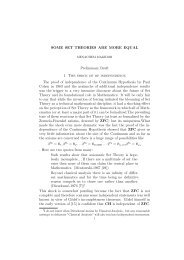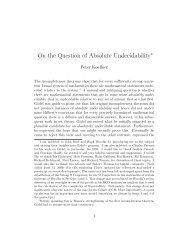The Continuum Hypothesis - Logic at Harvard
The Continuum Hypothesis - Logic at Harvard
The Continuum Hypothesis - Logic at Harvard
Create successful ePaper yourself
Turn your PDF publications into a flip-book with our unique Google optimized e-Paper software.
arithmetic (orabout L(R)) inthepresence of largecardinals. Second, experiencehas shown th<strong>at</strong> the large cardinal axioms in question seem to answer allof the major known open problems about second-order arithmetic and L(R)and the set forcing invariance theorems give precise content to the claim th<strong>at</strong>these axioms are “effectively complete”. 9It follows th<strong>at</strong> if P is any homogeneous partial order in L(R) then thegeneric extension L(R) P inherits the generic absoluteness of L(R). Woodindiscovered th<strong>at</strong> there isavery special partial order P max th<strong>at</strong>has thisfe<strong>at</strong>ure.Moreover, the model L(R) Pmax s<strong>at</strong>isfies ZFC+¬CH. <strong>The</strong> key fe<strong>at</strong>ure of thismodel is th<strong>at</strong> it is “maximal” (or “s<strong>at</strong>ur<strong>at</strong>ed”) with respect to sentences th<strong>at</strong>are of a certain complexity and which can be shown to be consistent via setforcing over the model; in other words, if these sentences can hold (by setforcing over the model) then they do hold in the model. To st<strong>at</strong>e this moreprecisely we are going to have to introduce a few r<strong>at</strong>her technical notions.<strong>The</strong>re are two ways of str<strong>at</strong>ifying the universe of sets. <strong>The</strong> first is interms of 〈V α | α ∈ On〉, the second is in terms of 〈H(κ) | κ ∈ Card〉, whereH(κ) is the set of all sets which have cardinality less than κ and whosemembers have cardinality less than κ, and whose members of members havecardinality less than κ, and so on. For example, H(ω) = V ω and the theoriesof the structures H(ω 1 ) and V ω+1 are mutually interpretable. This l<strong>at</strong>terstructureisthestructureofsecond-orderarithmeticand, asmentionedabove,large cardinal axioms give us an “effectively complete” understanding of thisstructure. We should like to be in the same position with regard to largerand larger fragments of the universe and the question is whether we shouldproceed in terms of the first or the second str<strong>at</strong>ific<strong>at</strong>ion.<strong>The</strong> second str<strong>at</strong>ific<strong>at</strong>ion is potentially more fine-grained. Assuming CHone has th<strong>at</strong> the theories of H(ω 2 ) and V ω+2 are mutually interpretable andassuming larger and larger fragments of GCH this correspondence continuesupward. But if CH is false then the structure H(ω 2 ) is less rich than thestructure V ω2 . In this event the l<strong>at</strong>ter structure captures full third-orderarithmetic, while the former captures only a small fragment of third-orderarithmetic but is nevertheless rich enough to express CH. Given this, in<strong>at</strong>tempting to understand the universe of sets by working up through it levelby level, it is sensible to use the potentially more fine-grained str<strong>at</strong>ific<strong>at</strong>ion.9 For more on the topic of invariance under set forcing and the extent to which this hasbeen established in the presence of large cardinal axioms, see §4.4 and §4.6 of the entry“Large Cardinals and Determinacy”.13


